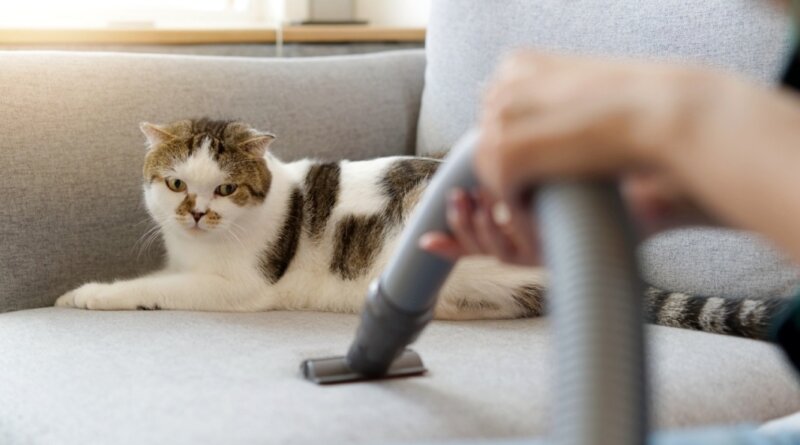How To Stop Shedding in Cats – Top Dog Tips
One of the most challenging parts of owning a pet is dealing with the shed hair on your furniture, clothing and around your home. I am often asked about tips and tricks to stop shedding, but the sad truth is that you can never completely stop your pet from shedding fur. However, I do have some great tips on how to stop shedding in cats that will greatly reduce the amount of shed fur that collects on your floors and sticks to your clothes and upholstery.
I’m sure you find your own hair on your pillowcase, around your bathroom sink and in your shower drain. Just like humans, it’s impossible to stop a cat from losing some fur. It is possible to reduce the amount of hair loss by improving the quality of your cat’s skin and coat, removing as much shed hair as possible as often as you can, and by keeping up with your cat’s regular grooming needs.
A few preventative measures can drastically reduce the amount of shed pet hair you find around the house. It’s really not that difficult to significantly reduce shedding, but it is time consuming. You’ll need to be diligent about proper grooming and take the time to tend to your cat’s coat nearly each day (depending on the breed/coat type).
How To Stop Shedding In Cats
 1. Use a Deshedding Tool
1. Use a Deshedding Tool
Standard brushes for cats can remove some shed hair, but deshedding tools are actually far more effective at removing loose fur from the coat. They can be found in any pet store, and you’ll usually find a variety to choose from. Look for a tool that is made for your cat’s coat type – long or short fur, thick or thin coat, etc…
I recommend researching the right product for your cat’s coat type, read customer reviews and visit the manufacturer’s website. If you’re unsure of exactly what you need, ask a local pet groomer for some advice.
Once you find the right tools, it’s time to start brushing your cat. This tip for how to stop shedding in cats seems pretty simple, but there is more to it than you may think – it’s all about the technique.
You’re going to need to brush your cat in the same direction as his fur. This is to ensure not only the most efficient way to deshed a cat, but also to keep your pet calmer and more relaxed. Basically, you want to brush from head to tail with long strokes. Stop to remove the shed hair from the brush as needed.
Do NOT press down on the brush. Unlike regular brushes, deshedding tools have a stainless steel head with a row of sharp teeth. These teeth are great for collecting loose hair from the coat, but if you press them into your pet’s skin they could cut into your cat.
The amount of time that you spend brushing your cat will vary depending on his coat type. I typically brush my cat for about 10 minutes every day, but when they are shedding a lot in the spring and fall, it could take up to 20 minutes to brush out all the loose fur.
You should continue brushing until you’re not getting any more fur in the brush. This is the only way to reduce your cat’s shedding. Of course, any amount of brushing will help but the more, the better. After all, whatever fur you do manage to remove from your cat is that much less that you will have to clean up around your home.
It will take a while in the beginning, but if you make brushing a daily habit you’ll be shaving time off of this task after the first few days. Just remember to stay consistent, or the loose hair will begin collecting and you’ll have to spend more time brushing your kitty companion.
ALSO: Can Multiple Cats Share A Litter Box?
 2. Bathe, If Necessary
2. Bathe, If Necessary
If your cat’s shedding is excessive, you can give him a bath to remove a large amount of the loose hair from his coat. Cats typically do not like bathing, so this could prove to be quite a difficult task. It may be easier if you ask another person to help you bathe your cat, as one of you will likely need to hold the cat while the other washes him.
Thoroughly wash your cat to remove most of the shed hair stuck in his coat. After bathing, you’ll need to brush your cat to remove the rest of the hair. Be sure that your pet is 100% dry before brushing him. If the coat is still wet, the brush will pull the fur and cause your pet pain.
3. Improve Your Cat’s Diet
Not all cat foods are created equal. For stronger hair and less shedding, feed your cat a high quality food enriched with vitamins, minerals, antioxidants and particularly Omega-3 essential fatty acids with a good balance of Omega-6 essential fatty acids.
A high quality cat food is more expensive, but it can actually save you money in the long run. You’ll be spending less on vet bills, grooming expenses and supplements. A well balanced diet will aid in your cat’s overall health and well-being, and you’ll be glad you upgraded his meals.
One of the best supplements to reduce shedding in cats is fish oil. These supplements have been scientifically proven to improve a cats’ coat and skin, and potentially reduce shedding. Fish oil is packed with omega-3 fatty acids which is what strengthens the coat and maintains better skin health in pets.
4. Hydrate
Along with a healthy diet comes good hydration. Water promotes hair growth and strengthens it by keeping a cat’s skin moisturized, resulting in a shinier, healthier coat. Proper hydration will decrease the amount of shed hair as well as reduce itching and flaking of the skin.
5. Reduce Stressors
Cats are very sensitive creatures. They can become easily stressed by a new environment, changes to their regular routine or an addition of a new pet into your home. If there is something causing your cat to be especially stressed, he may begin shedding excessively.
When stressed, a cat’s muscle will tense causing the follicles of some hairs to be released. This is completely normal, so you have nothing to worry about. You just need to make sure that you reduce the stress as much as possible to reduce shedding and help calm your pet.
READ NEXT: How Long Do Cats Live?
Related






